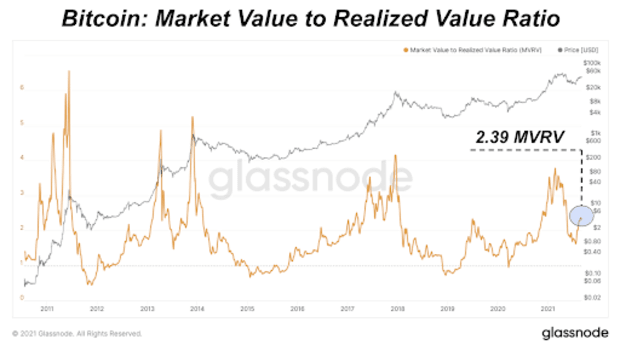Why You Shouldn’t Hedge Against Bitcoin With Stocks
Measuring assets’ value in terms of time can help us understand why Bitcoin’s potential upside is so much greater than that of stocks.
Written April 11, 2021
Why would someone go all in on bitcoin as opposed to diversifying into other asset classes, particularly stocks? Why not hold an index tracking fund like the S&P 500?
The short answer: because, as the premier monetary medium, bitcoin will absorb the monetary premiums of all other assets, including stocks.
You may be unsatisfied with this answer, but a full answer to the question “Why not hedge against bitcoin with stocks?” requires us to forecast bitcoin’s expected value and then compare it with the expected return on equity.
Today, people typically measure economic value in fiat currency units. But rather than using fiat as a unit of account, we need to look elsewhere. My thesis is that bitcoin will absorb all other assets’ monetary premiums, so we can’t start by measuring in terms of units that are expected to be absorbed.
In this article, I’ll present an alternative model for valuing Bitcoin. This model considers money to be a mechanism for storing time. Once we estimate how much stored time Bitcoin might represent, then we can backport this to today’s fiat currency units. Finally, we’ll compare these expected returns against holding a market cap weighted stock market index fund.
First, let’s talk about trade, which will lead to money and then speculation.
Trade, Money, and Speculation
Humans trade. We do and give things in exchange for other things. The expectation of repayment and people’s feelings of gratitude make this possible. When someone does something nice for us, we feel like we owe them something in return. This feeling undergirds our ability to cooperate with strangers.
But what about cooperation at scale? How do we keep track of who owes who what? Money is the technology that scales cooperation. As Dawkins said, “Money is a formal token of delayed reciprocal altruism” (Dawkins, 1989).
We accept money because we speculate that someone else will accept it in the future. This speculation is the primary purpose of money. We call this imputed value a good’s “monetary premium.”
When we talk about an asset’s price rise in a trading context, another way of looking at it is that we are forecasting its monetary premium. How much will this be worth to someone else in the future? We imagine a future buyer to which we will eventually sell the item.
One can speculate on the future value of anything. Money’s purpose is to be the item one holds because they have the highest confidence that others will accept it later. The markets for other assets may dry up, but you expect that people will still accept your money.
Bitcoin And Monetary Premium
Bitcoin is the premier monetary medium for a number of reasons. Here are just three:
First, unlike a physical monetary medium (gold), Bitcoin is digitally native. The electronic representation of Bitcoin is the thing itself. It is not a credit instrument. Anyone can independently verify the ledger in its entirety, without relying on a trusted third party.
Second, Bitcoin is decentralized. Unlike competing digital monetary media (fiat), Bitcoin’s supply does not depend on the beneficence of a select few.
Third, unlike competing payment networks (banking), transferring bitcoin does not rely on entrusting intermediaries.
For these reasons, I expect Bitcoin to absorb the majority of the monetary premiums of all other goods worldwide for the foreseeable future. Estimating what that means for the spot price of bitcoin requires comparing it to some other quantity. But to what can we compare Bitcoin?
We can’t use fiat for this comparison because we presuppose that Bitcoin will absorb fiat’s monetary premium. So what else can we use? How do we measure the aggregate global monetary premium without resorting to pricing based on existing monetary media?
Time
One answer is time. Time is an egalitarian estimate of total monetary premium that does not resort to pricing based on monetary media. Time is the great equalizer: everyone only has 24 hours in each day.
Every living organism must secure the resources needed for its continued existence. There are no exceptions. So in a sense, having money gives you time. By having money, you can afford to stop earning income for a time and spend out of your savings.
Different people have different preferences regarding how much time they’d like to have in reserve, and these preferences themselves change over time. Therefore, any imagined average is destined to be wrong. But we can still guess.
According to a 2020 Acorn study, the average amount that Americans need to have saved to feel comfortable is about $76,700. This figure is quite similar to the Department of Housing and Urban Development’s estimated median American family income in 2020 ($78,500). Accordingly, it stands to reason that a good initial approximation of desired saved time is about 1 year per person.
Storing Years In Bitcoin
The current world population is estimated to be ~7.9 billion people. If each person wants to store 1 year of value, that’s 7.9 billion person-years saved. This number will change based on preferences and changes in population.
However, there will never be more than 21 million bitcoin. So, for all of Bitcoin to encode all of the desired ~7.9 billion years of person-time, each Bitcoin must represent:
7.9 billion person-years / 21 million BTC = 376 person-years/BTC.
Then, 1 year’s worth of bitcoin should cost:
1 year / 376 person-years/BTC = 0.00266 BTC (266,000 satoshis).
Now that we’ve worked out a rough estimate of each bitcoin’s value in terms of human time, let’s fold the fiat currency price back in. Then, we can compare the results to our expected returns in the stock market.
Computing Fiat Equivalents
What is the fiat cost of 1 year of bitcoin savings? At today’s fiat spot price (~$60,000/bitcoin), 1 human-year of bitcoin saved costs:
$60,000/BTC ✕ 0.00266 BTC = ~$160.
So for $160, at today’s price, one can buy 1 person-year worth of stored time in the native instrument of that value.
But what would be the fiat equivalent in today’s value if Bitcoin had already reached saturation? For that, we need an estimate of annual income in fiat terms.
Estimates of global median income vary, but $10,000/year seems to be a conservative number. If 0.00266 BTC is to encode 1 person-year of time at the global median income of $10,000, that implies a fiat price of:
$10,000/year / 0.00266 BTC/year = $3.76 million per BTC.
Dividing that price by today’s price gives the expected return between here and saturation:
$3.76 million / $60,000 = 62.7✕.
As a percentage gain, that’s:
(62.7✕ – 1✕) ✕ 100 = 6170%.
Based on this model, and given conservative estimates, I expect holding bitcoin to yield roughly 6100% gains (in today’s dollars) before we reach an equilibrium price (in terms of person-time saved). Once that happens, it might make sense to diversify into other yield-bearing assets, provided that they aim to produce yield in Bitcoin terms.
Now that we’ve established a hypothetical target Bitcoin price based on stored time, we can compare the expected gains between here and there with the expected return on a market cap weighted stock market index.
Comparison With Stocks
How does our projected bitcoin valuation model compare with investing in stocks? According to Goldman Sachs, the stock market’s average rate of return has been ~9.2% for the last 140 years, but that rate may soon drop. Projecting forward, to achieve our expected 6100% gains in the stock market in dollar terms, one should expect to wait:
62✕ = 1.092t ⇒
Log(62) = t ✕ log (1.092) ⇒
t = log(62) / log (1.092) = 47 years.
Will it take Bitcoin less than 47 years to absorb the monetary premiums of all other assets (including stocks)? I think so. Until then, speculating on anything else seems like a gamble.
But that’s just my opinion.
This is a guest post by Jimbo the Consensualist . Opinions expressed are entirely their own and do not necessarily reflect those of BTC, Inc. or Bitcoin Magazine.









